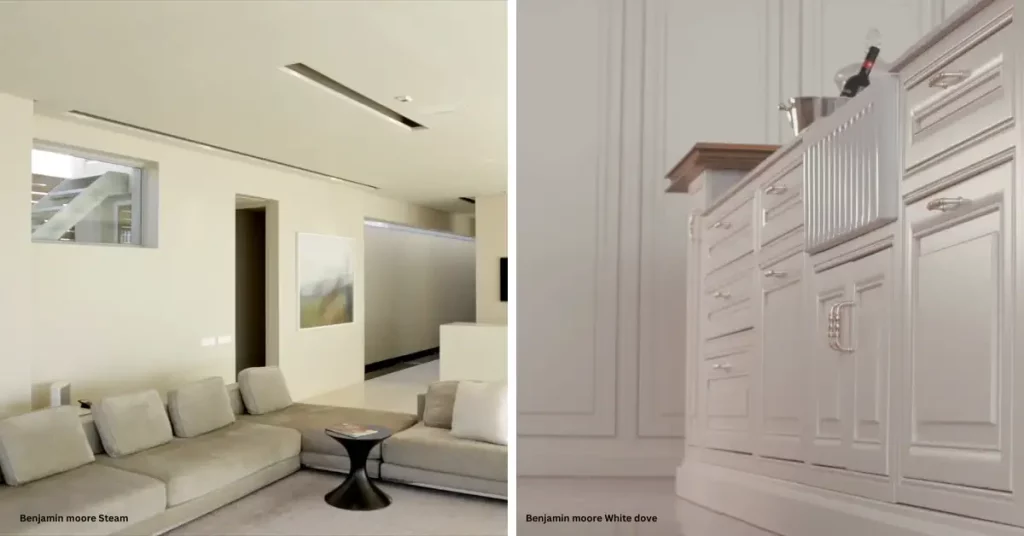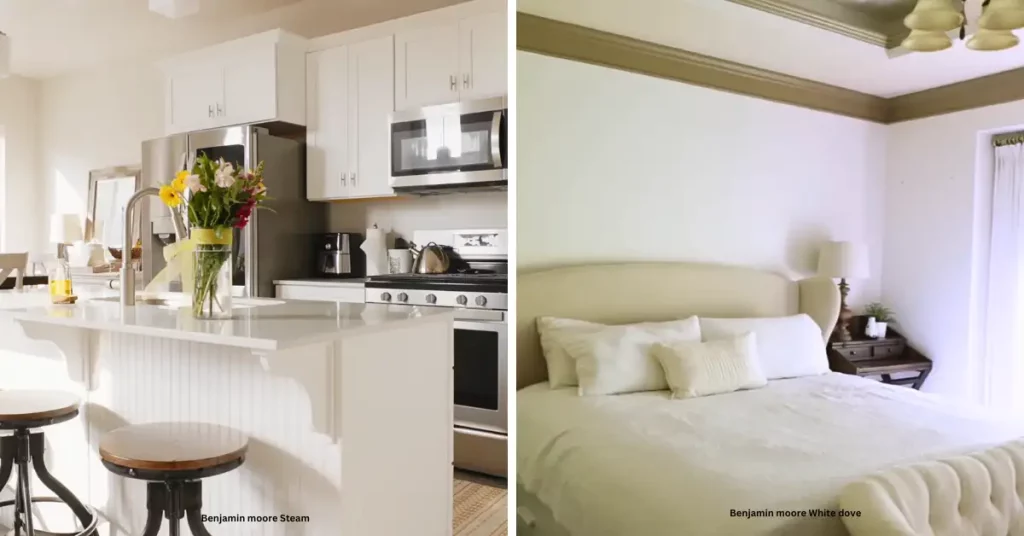When it’s time to paint your home, one of the most crucial decisions you’ll make is selecting the right color. With countless shades available, it’s easy to feel overwhelmed and uncertain of which hue will suit your space best. You may be considering two colors: Benjamin Moore Steam and White Dove.
Each of these shades has unique qualities like undertones, brightness, lighting, finishes, versatility, accents, and uses that can make them an excellent choice for your home.

Today, we’ll delve into the characteristics of Benjamin Moore Steam and White Dove and compare them side by side, helping you make an informed choice for your next home improvement project.
Here Are the Differences between Benjamin Moore Steam Vs White Dove
While both offer a clean and timeless look, some subtle nuances between the two shades can drastically alter the look and feel of a room. A few differences exist between Benjamin Moore’s Steam and White Dove that should be taken into consideration:
Undertones
The main difference between Benjamin Moore’s Steam and White Dove is their undertones. Steam has a warm or cool white undertone, while White Dove has a more subtle, warmer greige or yellow undertone. This creates an overall warmth in the room when using White Dove, compared to a cooler feel when using Steam.

Both colors also create different atmospheres depending on the lighting in the room. Steam can appear bluer in cooler lighting, while White Dove may appear more yellow in warmer lighting.
Brightness
Steam is slightly darker than White Dove, making it better suited for rooms that need more depth or moodiness. But, this brightness difference can be changed by selecting different finishes for each color. Matte finish softens the look of both colors, while eggshell adds a subtle sheen to the walls.
Semi-gloss and high-gloss finishes are great for creating a brighter look with either color but should be used sparingly as too much gloss can reflect too much light and make a space appear garish.
Lighting
Both colors can appear differently depending on the room’s size and type of lighting. Steam tends to take on a bluer hue in natural light, whereas White Dove often looks warmer due to its underlying yellow undertone.
Artificial lighting can also affect how these two colors look. Fluorescent lights will make them both look brighter, while incandescent lighting casts more of a warm glow on the walls.
Finishes
When choosing between Benjamin Moore Steam and White Dove, it’s essential to consider the finish you’d like to use and the color itself. Both are available in multiple finishes, including matte, eggshell, satin, semi-gloss, and high-gloss.
The matte finish gives a velvety appearance with less sheen than other finishes, while eggshell adds just enough luster without being overly shiny or reflective. The satin finish gives off medium shine but still has some texture to it, while semi-gloss is shinier than satin but still maintains some texture in its appearance.
High gloss is best used judiciously as its extreme shine can quickly become overpowering if used too liberally throughout your home.
Versatility
White Dove and Steam are versatile colors that can be used in traditional and modern spaces. White Dove is better suited to traditional and transitional spaces, while Steam works best in contemporary settings. White Dove has a warm tone that fits almost any style, while Steam’s cool tones lend themselves to minimalist decorating schemes.

Accents
White Dove is a very neutral color that pairs well with many different accent colors, including blues, grays, browns, beiges, taupes and other warm colors. On the other hand, Steam’s cooler tones work best when paired with other cool tones like blues and greens.
And when it comes to painting accent walls, White Dove is a great option because its subtle yellow undertone will make the wall look warm and inviting. In contrast, Steam may appear too cold when used as an accent color in a room.
Use in Different Rooms
White Dove has become a popular choice for living rooms, kitchens and bedrooms due to its versatility, as it can give these spaces a feeling of warmth. In addition to this, it can also be used in bathrooms or home offices as an accent color to create a calming atmosphere.
Meanwhile, Steam works best when used in areas such as basements or bathrooms, where it will stand out against lighter furniture or shades of white paint.
Complementary Colors
White Dove pairs well with other warm colors like beige, taupe and even some greys for an elegant touch. For those looking for something more dramatic, then adding a deep blue or green can really make the colors pop.
Alternatively, Steam looks great with cool colors like light blues and grays, creating a sophisticated palette perfect for modern spaces.
Mood
White Dove and Steam can both be used to create an inviting atmosphere, but the feeling they evoke is different. White Dove has a warm undertone and brings a sense of peacefulness and comfort to a room.
Conversely, Steam has a cooler tone that can create a calming and tranquil atmosphere in any space. Furthermore, its more subtle hue elicits feelings of relaxation and serenity.
Popularity
White Dove is currently the more popular choice due to its versatility in various residential and commercial spaces.
Then again, Steam is quickly gaining popularity for its ability to bring a soothing atmosphere into any room. Its understated hue makes it a great choice for creating a restful ambiance without being overly bold or bright.
Ultimately, whether you choose White Dove or Steam will depend on your style and mood preference.
Create a Relaxing and Inviting Atmosphere in Your Home
When choosing between Benjamin Moore Steam and White Dove, you must consider the undertones, lighting, finishes, versatility, and mood you want to create in your space.
Both colors have unique features that make them excellent options for different areas of your home. Whether you’re looking for a warm, inviting atmosphere or a calming and relaxing environment, Steam and White Dove can help you achieve the desired look.

S. Pushon is a paint expert, self-taught artist, and currently working as an adviser in the paint industry as a Quality Improvement and Development Assistant.
An artist by heart, he draws remarkable art pieces and as a professional paint industry individual, he seeks the insight and shares with enthusiasts. Read more…
